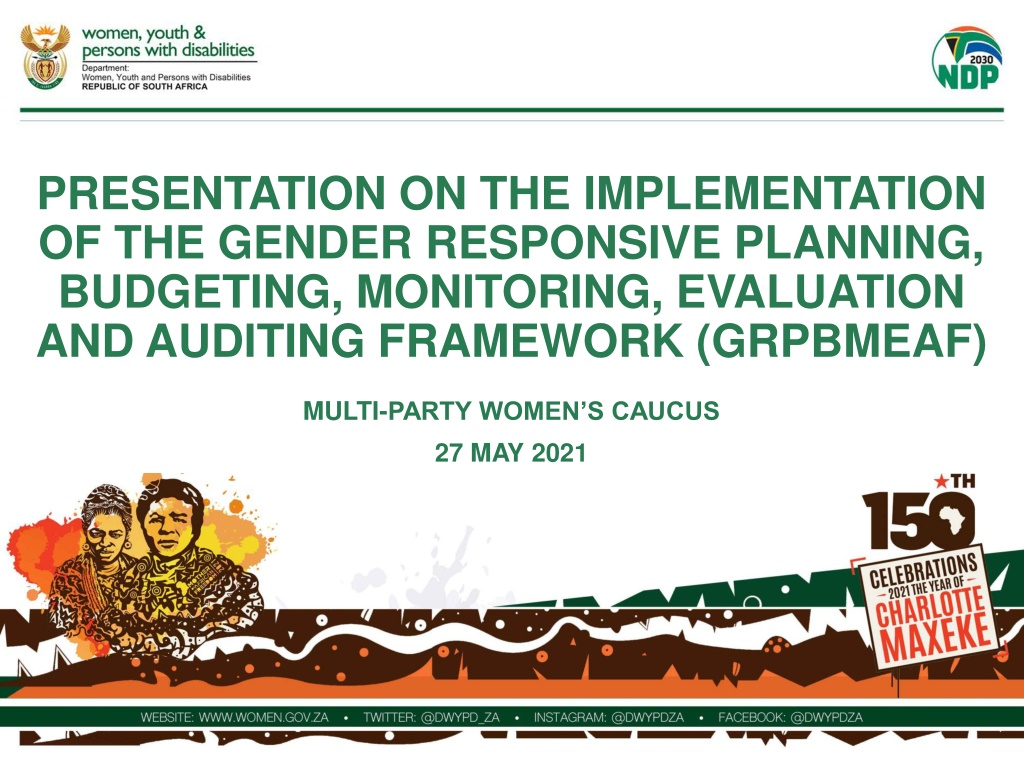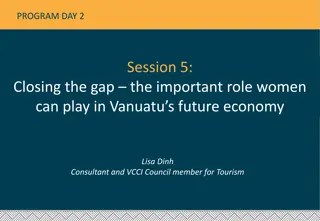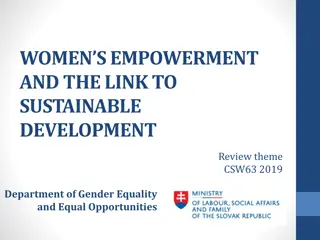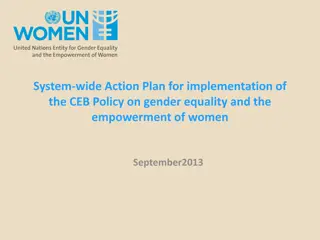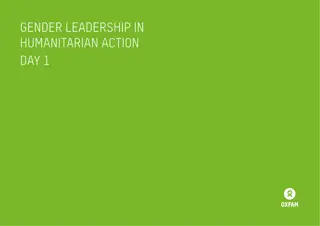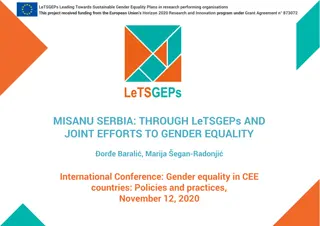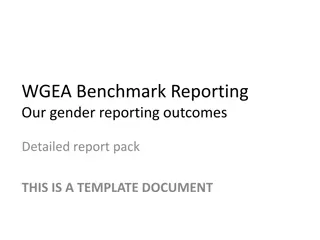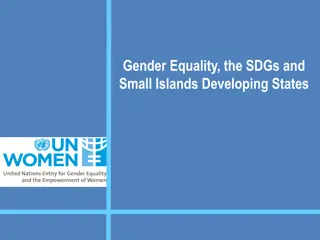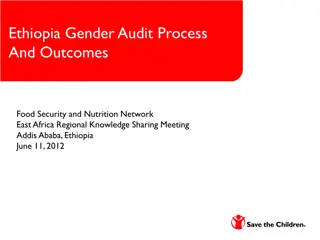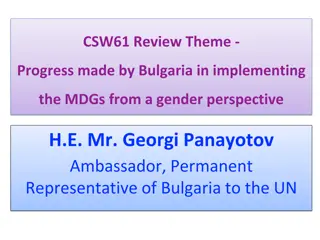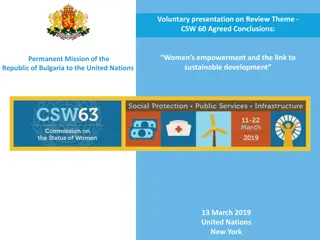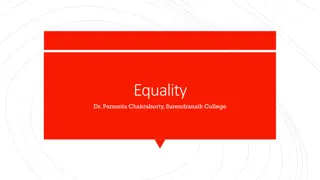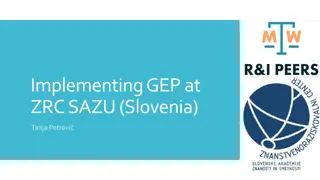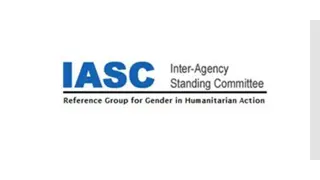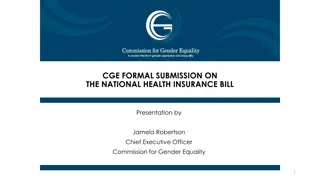Advancing Gender Equality Through the GRPBMEAF Framework Implementation
Despite progress in gender policy and budgeting, South Africa faces challenges in gender mainstreaming. The GRPBMEAF framework aims to shift towards gender mainstreaming, prioritize Women Empowerment and Gender Equality, allocate adequate resources, and promote a non-sexist society. By integrating gender across all sectors and ensuring transparent financing, the framework seeks to enhance inclusive growth and political transformation.
Download Presentation

Please find below an Image/Link to download the presentation.
The content on the website is provided AS IS for your information and personal use only. It may not be sold, licensed, or shared on other websites without obtaining consent from the author. Download presentation by click this link. If you encounter any issues during the download, it is possible that the publisher has removed the file from their server.
E N D
Presentation Transcript
PRESENTATION ON THE IMPLEMENTATION OF THE GENDER RESPONSIVE PLANNING, BUDGETING, MONITORING, EVALUATION AND AUDITING FRAMEWORK (GRPBMEAF) MULTI-PARTY WOMEN S CAUCUS 27 MAY 2021 1
Introduction and Background Following advances in first phase of democracy in gender policy, planning and budgeting (GRB), more recently SA has experienced a gender mainstreaming regression Poor accountability for Women Empowerment and Gender Equality (WEGE) performance across state sector. Key WEGE policies and systems outdated. Weak institutionalisation of gender mainstreaming. Lack of coherent gender planning, budgeting, monitoring and evaluation and gender auditing, policies, programmes and systems. Many policies are gender blind/silent. responsive policy, research, 2
Introduction and Background The Framework on GRPBMEA was approved by Cabinet on 27 March 2019 for implementation across the country with the following key strategic objectives: To serve as a catalyst to effect a system-wide paradigm shift towards gender mainstreaming across the state machinery To ensure WEGE are at the centre of public policy priorities, results-based planning, budgeting and accountability; To ensure the allocation of adequate and equitable resources for WEGE linked to broader public finance reforms; To enhance the country s overall levels of inclusive growth, development and the broader political and socio-economic transformation agenda. To contribute to the achievement of our Constitutional vision of a non-sexist society and gender equality. 3
Introduction and Background The overall approach of GRPBMEAF is to ensure that: WEGE is not only a social sector issue but cuts across all sectors and desired outcomes especially economic empowerment, political participation, etc. Aims to ensure country, government-wide planning and budgeting processes to promote stronger institutional accountability to gender equality commitments incl. Need for comprehensive and integrated approach Gender-responsive policy and programmes at national, sectoral and local level Gender-responsive institutions administration Gender-responsive financing which is transparent and adequate & systems of public 4
Introduction and Background The approach and strategy for the successful implementation include: Pragmatic approach, multi-pronged, short to medium-term strategy Mainstreaming gender within existing national PME systems. Mainstreaming gender within existing budgeting systems, procedures and performance-based budgeting initiatives. Country Gender Indicator Framework linked to normative frameworks (from SDGs to programme performance) Accessing multiple evidence and data sources including government, civil society, academia etc. WEGE interventions and programmes based on diagnostic and desired outcomes for women & girls. Piloting in different contexts implementation theory. to test both conceptual and 5
Introduction and Background Achievement of country gender outcomes requires: Setting clear gender responsive across government assessment Translating policy priorities into programmes: With clear programme outcomes With gender-responsive indicators and targets With targeted interventions, interventions Allocation of budgets to achieve gender priorities and expenditure review against gender outcomes. policy priorities diagnostic/needs based on mainstreamed 6
Introduction and Background GRPBMEA implementation linked to: Institutionalisation of gender mainstreaming across state machinery. Broader political and socio-economic transformation agenda. Outcomes and results-based approach. Government-wide policy, planning and prioritisation. Broader public finance and budget reforms. 7
Ten (10) pillars of the GRPBMEAF implementation The implementation GRPBMEAF is based on the following 10 pillars: 1.Gender-responsive country planning and monitoring 2.Gender-responsive institutional planning 3.Gender-responsive policy priorities 4.Gender-responsive evaluation, knowledge and evidence 5.Gender-responsive monitoring and auditing 6.Gender-responsive budgeting 7.Other related systems, incl. cabinet and parliamentary systems 8.Gender-responsive legislation 9.Gender-responsive performance management 10.Communication, advocacy and training 8
Progress on implementation Pillar 1: Gender-responsive country planning and monitoring 2019-2024 electoral mandate includes gender priorities NDP review including chapter on WEGE initiated. 2019-2024 MTSF: Explicit on gender priorities, deliverables, indicators and impacts that cut across the seven priorities towards : A gender, youth and disability responsive public service. Transformed, representative and inclusive economy which prioritises women, youth and persons with disabilities. 9
Progress on implementation Pillar 1: Gender-responsive country planning and monitoring All women, girls, youth and persons with disabilities enjoy good quality health care and better life opportunities. Human dignity for persons with severe disabilities, women and girls achieved through freedom of choice and decent living conditions. Transform ownership and management patterns by supporting women- owned and led enterprises All women, girls, youth and persons with disabilities are and feel safe and a better life. A better Africa and world for all women, girls, youth and PwDs. 10
Progress on implementation Pillar 1: Gender-responsive country planning and monitoring Other areas of progress include the following: Development of Country Gender Indicator Framework Commitment to ensure Mandate Framework is gender-responsive 25-year Review on Women s Empowerment and Gender Equality, approved by cabinet in December 2020 Chapter on WEGE in government 25-year review SONA 2020 & 2021 significant WEGE content, incl. on women s economic inclusion, gender in the context of the AU Chairship, access to land and GBV. Development of GRPBMEA Implementation Guidelines GRPB inclusion on the District Development Model 22 Paper/ Budget Prioritisation 11
Progress on implementation Pillar 2: Gender-responsive institutional planning Guidelines on assessment of Draft Strategic Plans and APPs include an annexure that assess the responsiveness to women, youth and persons with disabilities(DPME, 2019). This assist institutions to include WYPD priorities in Strategic Plans & APPs. Analysis of gender, youth and disability responsiveness of selected Strategic Plans and APPs was conducted and feedback provided to the department. DWYPD assessed the draft APP 2021/22 for WYPD responsiveness to feedback into the final APP The assisted in improving gender responsive plans that have women- focused interventions aimed specifically at better outcomes for women and girls/ gender equality. 12
Progress on implementation Pillar 3: Gender-responsive policy priorities Policy priorities were presented to the Portfolio Committee on the 9th October 2020. Development of proposed Gender Policy Priorities for 2019 to 2024 and to 2030 from multiple sources, including stakeholder dialogues and international frameworks. 13
Progress on implementation Pillar 4: Gender-responsive evaluation, knowledge and evidence The department provided inputs into the Gender Responsive National Evaluation Policy Framework (NEPF), which ensures the inclusion and integration of a gender perspective across the evaluation cycle. This result in government with: Gender-responsive National Evaluation Plan (NEP); Targeted gender-responsive evaluations; Gender-responsive evaluation guidelines; Rapid Evaluation of the GRPBMEAF was conducted in 2020; and Formative evaluation on the framework that the department is undertaking this 2021/22 financial year. Development of a Gender Knowledge Hub with a view to have a central repository for gender, youth and disability information for the country. 14
Progress on implementation Pillar 5: Gender-responsive monitoring and auditing DWYPD has engaged with DPME on possible collaboration to strengthen gender responsive monitoring systems Country Gender Indicator Framework (CGIF) monitoring tool is being finalised for WEGE performance tracking. An annual performance monitoring report was produced. 15
Progress on implementation Pillar 5: Gender-responsive monitoring and auditing . The CGIF contains indicator from national, regional and global instrument that South Africa is party to. The CGIF is currently being presenting the through the government Cluster system for support in implementation and reporting. DWYPD has initiated a request to engage the Auditor General on the gender responsive auditing systems 16
Progress on implementation Pillar 6: Gender-responsive budgeting Department is working with National Treasury, for the first time NT issued the 2021 MTEF technical guidelines that included budget tagging for gender, youth and persons with disabilities. Discussions are continuing on the disaggregation of the procurement data to track the 40% spent A Meeting was held on gender responsive fiscal policy reforms 17
Progress on implementation Pillar 6: Gender-responsive budgeting The selected department to provide expenditure data in the MTEF budget process on Eradication of Gender Based Violence and Femicide and Social transformation and governance economic inclusion, Women s Gauteng Responsive Budgeting Province has started piloting on the Gender Proposal to conduct training on gender budgeting are underway 18
Progress on implementation Pillar parliamentary systems DWYPD GRPBMEAF and CGIF to Portfolio Committee on the 9th October 2020. Rapid evaluation was presented at three DG clusters International obligations WEGE indicators arising from international and regional instruments have been included in the CGIF to influence government planning and data collection systems. DWYPD continues to develop international reports as required, e.g. the country s Beijing +25 report. 7: Other related systems, incl. cabinet and has presented on the Policy priorities, the 19
Progress on implementation Pillar 8: Gender-responsive legislation The department has initiated the process to draft the WEGE Bill in 2021/22, with possible tabling in 2022/23. 20
Progress on implementation Pillar 9: Gender-responsive performance management Commitment by DPME to include the gender specific indicators in the HOD assessment framework and to include DWYPD during the moderation of the quarterly performance reviews. Commitment by accountability for gender performance at all levels of the public service. DPSA to review PMDS system to ensure greater President committed to inclusion of gender-specific delivery targets in Performance Agreements of Ministers, Premiers, DGs and senior managers. 21
Progress on implementation Pillar 9: Gender-responsive performance management The department assessed the performance agreement of Ministers and the President Majority implementation of the GRPBMEAF and National Strategic Plan on GBVF. of the Ministers performance agreement committed to the This lays a foundation for institutionalisation of gender mainstreaming in the public sector 22
Progress on implementation Pillar 10: Communication, advocacy and training DWYPD working with National School of Governance (NSG) and DPSA developed and accredited training module on Gender responsive budgeting The module was use by the NSG to conduct eight virtual training sessions from August 2020. A total of 216 officials has been trained to date and a plan to continue with the roll out of training is in place. A number of National Department invited the department for capacity building such as Health, Public Enterprise, Trade, Industry and Competition, Human Settlement, Tourism etc 23
Progress on implementation Pillar 10: Communication, advocacy and training The department has set up structures such as the High Level Steering Committee and Provincial workshop and host meeting every two month The meeting serve as platform for learning, capacity building and sharing of best practices These meetings have been well attended. Individual departments and Department to capacitate their official, particularly during their strategic meeting toward mainstreaming Provinces include KwaZulu-Natal and North West hosted the department twice, Gauteng Treasury and Mpumalanga recently, on 13 May 2021 provinces request the institutionalisation of gender 24
Conclusion Significant progress has been made on the implementation of the framework at various policy levels. There is still a serious gap in institutionalisation/implementation of the Framework at departmental level The departments should ensure that the strategic plans and annual performance plans are gender, youth and disability responsive in line with the DWYPD revised assessment framework on the WYPD responsiveness of SP and APP 25
Conclusion There is a need to support government at both national and provincial level to mainstream gender, youth and disabilities in plans and budgets as well as monitoring its implementation and reporting in a disaggregated manner. There is insufficient capacity (warm bodies) in the DWYPD to provide technical support to all government and provinces to ensure institutionalisation of the GRPBMEA framework, however, the capacity of Gender Focal Points can be leveraged on if their authority is recognised and utilised appropriately. 26
. THANK YOU INKOMU SIYABONGA RE A LEBOGA DANKIE 27
